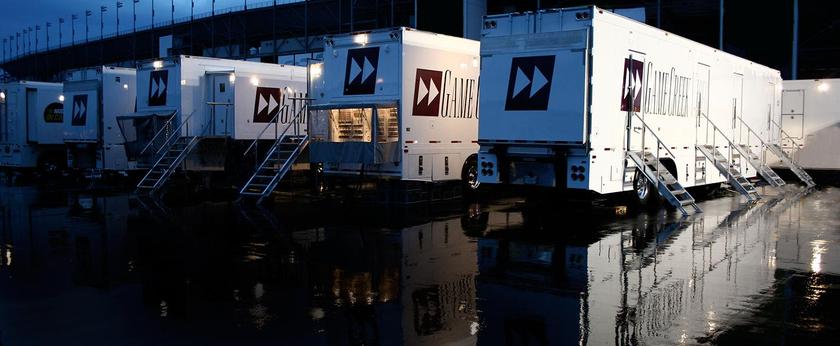Analog video noise
Figure 1. Various types of random noise spectra. Click here to see an enlarged diagram.
Random noise
Noise is defined as an unwanted parasitic signal superimposed on the wanted signal. The effect of the noise on the reproduced picture is expressed as signal-to-noise ratio (SNR). As a signal passes through a cascade of amplifier stages or devices, the SNR decreases after each stage because noise is added in each stage. Two types of noise will be considered in this article: random noise and coherent noise.
Random noise is generated by circuit elements. It is the consequence of the granular structure of matter and, thus, it can be reduced but cannot be completely eliminated. A given circuit will have a specific SNR, which cannot be improved.
Figure 1 outlines the spectral distribution of the types of random noise encountered in practice. Flat frequency response amplifying devices generate white noise, whose power density is constant with frequency. Devices that emphasize the higher frequencies with respect to the lower frequencies of the spectrum exhibit triangular noise, whose power density is proportional to the square of the frequency. The noise spectrum is modified by the characteristics of the discrete elements that constitute a system. As a consequence, white and triangular noise are seldom encountered in pure form. Equalizing distribution amplifiers are characterized by hypertri-angular noise, where the distribution is approximately triangular at low frequencies and approaches a parabola at higher frequencies.
Figure 2. Equipment setup for noise measurements. Click here to see an enlarged diagram.
Luminance random noise
Get the TV Tech Newsletter
The professional video industry's #1 source for news, trends and product and tech information. Sign up below.
Figure 2 shows the conceptual equipment setup for the measurement of video noise. The bandwidth of the random noise accompanying the video signal may be considerably greater than that of the video signal. This is due to the fact that the noise bandwidth is determined by equipment and circuits handling the signal, whereas the video bandwidth is primarily determined by the picture reproducing equipment with limited resolution capability. Eventually, the noise and the signal bandwidth are made equal by the transmitter and the receiver.
It is evident that a serious error is possible in the measurement of the SNR unless arrangements are made to make the noise and the signal bandwidth equal at the point of measurement. For this reason, the noise is measured in a frequency band extending from 10kHz to the upper limit of the video band (4.2MHz in NTSC; 5MHz, 5.5MHz or 6MHz in PAL). The lower frequency limit ensures that hum is not measured as random noise. The upper limit ensures that irrelevant high frequency noise is removed from the measured signal. Certain authorities also use a weighting filter approximating the eye response. To measure random noise, the timebase of the oscilloscope is set to display one TV line.
The effect of random noise on the luminance component of the picture is seen as a fluctuating pattern of black and white specks. The pattern is relatively coarse in the case of white noise and fine-grained in the case of triangular noise. Given the low sensitivity of the eye for fine luminance details, moderate amounts of triangular noise affecting the luminance are quite tolerable.
The typical test signal for the measurement of noise is a flat field at the black level (i.e a luminance level of 0 IRE). The luminance random SNR is defined as:
SNR(dB) = 20 log10 (p-p video signal voltage/RMS noise voltage)
where the p-p amplitude (reference) of the video signal is 714mV for the 525/60 system and 700mV for the 625/50 system.
Specialized equipment gives a direct reading as per the formula above. Oscilloscope measurements of luminance SNR necessitate a conversion from peak-to-peak noise voltage, as displayed on the oscilloscope screen, to RMS noise voltage. To measure the SNR, the “quasi” peak-to-peak amplitude of the noise is carefully estimated, and a conversion factor is added to obtain the RMS noise value. Various organizations use conversion factors between 14dB and 18dB. 15dB is the commonly used value. The SNR is consequently calculated as per the formula:
SNR(dB) = 20 log10 (p-p video signal voltage/p-p noise voltage) + 15
Figure 3. Random noise displayed on a wideband oscilloscope, with a vertical sensitivity of 20mV/cm and bandpass of 20MHz. Click here to see an enlarged diagram.
Figure 3 shows the display of random noise on a wideband oscilloscope, with a sensitivity of 20mV/cm and a spectral response extending up to 20MHz. In this example, the p-p amplitude of the random noise is about 140mV, and the calculated SNR is:
SNR(dB) = 20 log10 (714/140) + 15 ≈ 29dB
Figure 4 shows the display of the same random noise on a video waveform monitor, with the bandwidth limited to 4.2 MHz. In this example the p-p of noise is about 20 IRE or about 14mV, and the calculated SNR is:
SNR(dB) = 20 log10 (714/14) + 15 ≈ 49dB
Chrominance random noise
A significant difference! It is evidently essential to specify the bandwidth of noise measurements when quoting SNR figures.
Figure 4. Random noise displayed on a video waveform monitor, with a vertical sensitivity of 10 IRE/division and bandpass of 4.2MHz. Click here to see an enlarged diagram.
The effect of random noise on the chrominance component of the picture is rather different. Noise components that have comparatively little impact on the luminance assume a greater importance in a color signal.
Essentially, the chrominance information is transmitted as amplitude and phase modulation of a suppressed sub-carrier in NTSC and PAL, hence as double sideband components in the spectrum centered around 3.58MHz (NTSC) or 4.43MHz (PAL).
White and triangular noise components in the spectrum around the color subcarrier are demodulated in the receiver or monitor as comparatively low-frequency signal amplitude fluctuations (<500kHz) and are seen as a coarse pattern of colored specks. The SECAM system is relatively immune to chrominance noise due to the frequency modulation of the chrominance subcarriers. The measurement of chrominance SNR has not been internationally standardized. Several manufacturers have developed “de facto” measurements methods. A full-field signal with a set chrominance level and phase is used a test signal. The noisy signal at the output of the equipment under test is band-pass filtered to extract the chrominance information. The chrominance information is demodulated, and its random variations of amplitude and phase, with respect to a standard reference, are measured as amplitude noise and phase noise.
Coherent noise
The coherent noise is generated outside the equipment and coupled in some manner into it. This type of noise does not possess the statistical properties of random noise. It usually consists of one or more spurious signals of a periodic or quasi-periodic nature. The coherent noise can be avoided by good engineering practice, unlike the random noise. The picture impairment it causes is measurable as peak-to-peak noise. The signal to coherent noise ratio is defined as:
SNR(dB) = 20 log10(p-p video signal voltage/p-p coherent noise voltage)
Table 1: Single-pass performance of studio-type equipment in terms of noise. Click here to see an enlarged diagram.
The coherent noise may be hum or other periodic frequencies. (See Table 1). The measurement of hum uses a low-pass 10kHz filter. To measure the hum, the time-base of the oscilloscope is set to display one field. The oscilloscope gain is increased as convenient, and the p-p amplitude of the displayed waveform, a 60Hz sinewave, is measured. The SNR is calculated using the formula above.
Note that in NTSC, the hum (60Hz) is not coherent with the field frequency of 59.94Hz. As a consequence, with the oscilloscope synchronized to the video field rate, the 60Hz hum will be displayed as a movable waveform. Higher frequency periodic noise measurements use a 10kHz high-pass filter. It may be convenient to use a spectrum analyzer to identify the interfering periodic noise.
Michael Robin, a fellow of the SMPTE and former engineer with the Canadian Broadcasting Corp.'s engineering headquarters, is an independent broadcast consultant located in Montreal, Canada. He is co-author of “Digital Television Fundamentals,” published by McGraw-Hill and translated into Chinese and Japanese.
Send questions and comments to:michael_robin@primediabusiness.com












